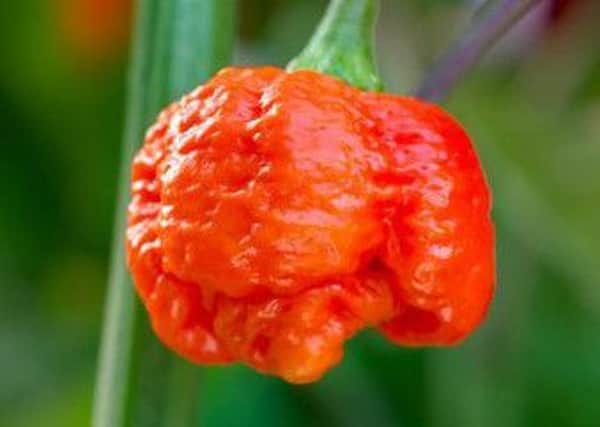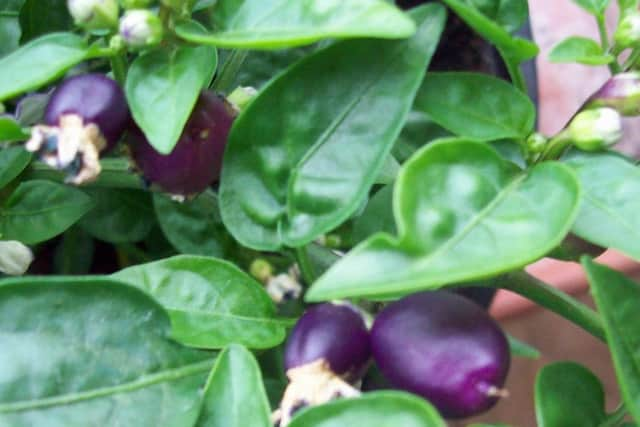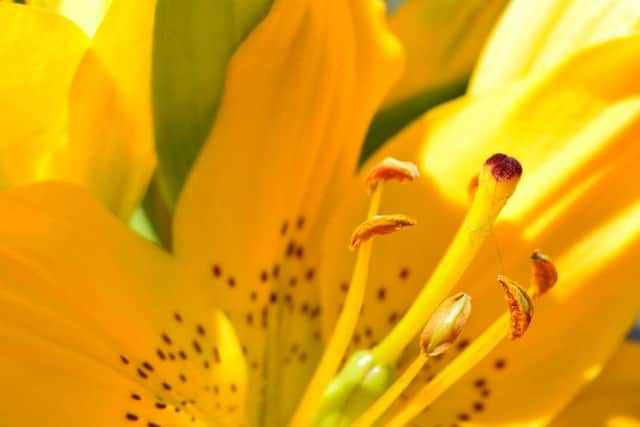GARDENING: Chilli growing is not all about intense heat


However, when I was sent a packet of Loco seeds to trial, it would have been churlish not to sow them – what a great plant. It’s compact (only grows to about 2ft) and bushy and covered with flowers.
You can’t deny how decorative it is – the inch-long cone-shaped fruits are held upright above the foliage like little fairy lights. The unripe fruits start purple/cream, changing from orange to red – the look like plump blackcurrants, but you’d get a shock if you ate one.


Advertisement
Hide AdAdvertisement
Hide AdLoco, despite its name, is not supposed to be that hot – slightly less than a cayenne pepper, a medium heat level of about 24,000 SHU*.
Which Gardening Chilli Trials recommended it as a ‘Best Buy’ and it was bred in the UK.
You can sow now in a propagator, but make sure you have a good light source. Seeds cost £2.99 a packet from Suttons, www.suttons.co.uk*The Scoville scale is the measurement of the pungency (spicy heat) of chillies or other spicy foods in Scoville heat units (SHU), a function of capsaicin concentration, named after its creator, US pharmacist Wilbur Scoville.
Other popular chillies in descending order of hellishness:


2,000,000-2,200,000 SHU: Trinidad Moruga Scorpion, Carolina Reaper.
Advertisement
Hide AdAdvertisement
Hide Ad855,000–1,463,700 SHU: Naga Viper; Bhut Jolokia (ghost pepper), Trinidad Scorpion Butch T pepper; Bedfordshire Super Naga.
100,000–350,000 SHU: Habanero chilli, Scotch bonnet pepper.
30,000–50,000 SHU: Cayenne pepper, Tabasco pepper.


10,000–23,000 SHU: Serrano pepper.
3,500–10,000 SHU: Jalapeño.
100–900 SHU: Paprika, Pimento.
0 SHU: Sweet bell pepper.


THE WORLD’S HOTTEST CHILLI
If you’re a chilli fan, you can now buy seeds of the world’s hottest variety, Carolina Reaper, from DT Brown.
Available as young plants last season, Carolina Reaper packs a volcanic punch of more than 2,200,000 Scoville Heat Units (SHU).
The company’s Tim Jeffries recommends gloves should be worn when handling the plants and fruits, which should always be cooked and never eaten raw.
Advertisement
Hide AdAdvertisement
Hide AdCarolina Reaper’s not simply about heat. It has a sweet, fruity flavour with chocolate and cherry undertones.
All super-hot chillies need to be sown early and require real warmth to get started. A heated propagator set at 28-30°C is ideal, because the hotter the chilli, the more time and heat it needs.
A packet of 10 seeds of Carolina Reaper costs £3.99, visit www.dtbrownseeds.co.ukJOBS FOR THE WEEKEND
Rhubarb can be forced for an early crop. Cover a crown with a bucket and insulate the outside with straw or compost for added heat.
Advertisement
Hide AdAdvertisement
Hide AdLily bulbs can be planted in pots, for flowers this summer. After growing on in a cool greenhouse, they can be moved on to the patio when in flower.
Check on tender plants overwintering outdoors to ensure protective coverings are still in place.
Continue to deadhead winter pansies and other winter bedding. Pansies will carry on into the spring and even to early summer, if attended to frequently.
Cut off old leaves of hellebores that produce flowers from ground level to expose the flowers and remove possible foliar diseases such as hellebore leaf spot.
Advertisement
Hide AdAdvertisement
Hide AdLook out for rots (such as crown rot, Sclerotinia, delphinium black blotch, black root rot and antirrhinum rust) on emerging perennials.
Many summer-flowering deciduous shrubs can be pruned now – those that flower on the current year’s growth, including Buddleja davidii, Ceratostigma, Hydrangea paniculata, Lavatera, Leycesteria, Perovskia, hardy fuchsias, and deciduous Ceanothus.
Prune Wisteria by cutting back the sideshoots shortened by summer pruning to two or three buds (2.5-5cm/1-2in). Avoid cutting off flower buds.
If you have any seedlings and/or cuttings in the greenhouse, make sure they are getting the maximum light available, or else they will become weak and leggy. If necessary, turn them once a day to get light on both sides.
This will stop them leaning over.
GET IN TOUCH
Advertisement
Hide AdAdvertisement
Hide AdFor more on these topics, plus cook what you grow, traditional recipes, North East information, environmental news and more, log on to www.mandycanudigit.com (now smartphone friendly), www.sunderlandecho.com/gardening, follow me on Twitter @MandyCanUDigIt or you can like me on Facebook at Mandycanudigit